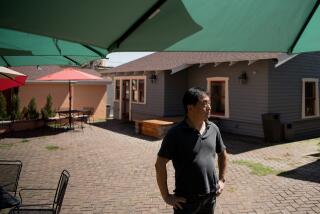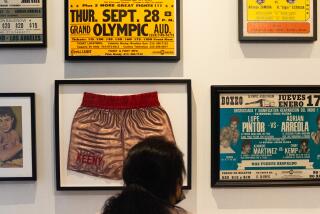Beijing revitalizes as 2008 Olympics nears
Beijing
Everywhere in the Chinese capital, it seems, something new is on the rise -- or something old is being renovated.
These changes were largely spurred by the 2008 Olympics but will leave a lasting mark on the city. Here are some of the things visitors will find going up around Beijing.
* A third terminal at Beijing Capital International Airport, about 15 miles northeast of the city, is scheduled for completion by the end of this year. It was designed by Norman Foster, the architect responsible for London’s Stansted and Hong Kong’s Chek Lap Kok airports, and it is expected to welcome 43 million passengers a year.
Even better, it will come with a light rail line linking the airport to the city center’s Dongzhimen station in 18 minutes.
* The 6,000-seat National Grand Theater has brought a bold, head-turning splash of modernism to the Tiananmen Square area, making the Great Hall of the People next door seem hopelessly stodgy by comparison.
The glass and titanium inverted-bowl-shaped building overlooks a reflecting pool and greenbelt. Inside are an opera house, a concert hall and a theater set to open at the end of this month.
* Qianmen Street, with its small shops, tea houses and theaters, was the commercial heart of Beijing during the Qing Dynasty (1644-1911).
Now, the district just south of Tiananmen Square is being turned into a pedestrian mall, complete with a free tourist trolley and underground parking garage. When work is completed, visitors will be able to stroll along the tree-lined, marble-paved thoroughfare and visit more than 80 renovated shops selling a variety of wares -- steamed buns as well as antique porcelain.
Qianmen Street will soon be joined by a glitzy entertainment complex in the former U.S. Embassy compound, a part of the old Legation Quarter at the southeastern corner of Tiananmen Square.
It will have restaurants, bars, galleries, theaters and nightclubs.
* Upscale shopping centers such as Oriental Plaza near Wangfujing and Shin Kong Place in the Central Business District have become commonplace in Beijing. But the Place, a new mall on the western side of the Central Business District, has something more than Adidas and Gucci: a 98-foot-wide LED screen suspended high over the courtyard, showing movies, promotional videos, satellite TV and shoppers’ own digitally uploaded photos.
* Early in 2006, the China National Film Museum opened in a still somewhat rural area about a 45-minute drive northeast of the city. But it’s worth the trip because the massive, state-of-the-art facility, designed by U.S.-based architectural firm RTKL, has an Imax theater, four cinemas and a permanent exhibition on the history of Chinese film. Among its fascinations are a segment from “Conquering the Jun Mountain,” featuring the Peking Opera, and a display on the cinema during the Cultural Revolution, when the Chinese film industry “met with complete and comprehensive destruction,” according to an explanatory note.
* Ongoing restoration of some of the major sights in the Forbidden City, such as the Meridian Gate and the Hall of Supreme Harmony, has intensified in preparation for the Olympics. Less apparent is work underway on the northeastern side of the palace, where Qing Dynasty Emperor Qianlong built a retirement retreat consisting of four courtyard enclaves connected by winding passageways, moon gates and rock gardens. Closed and virtually untouched for decades, Qianlong Garden is now being renovated by the government, with the help of the New York-based World Monuments Fund.
It will take until 2012 to complete the work, but the lodge, with an exquisite private theater, is to open next year.
* In 2005, the Capital Museum, formerly near the Confucius Temple, moved to a striking new contemporary building near the Muxidi subway stop in western Beijing. With five floors of handsome galleries, it is an essential stop for travelers interested in the history and culture of Beijing. The Peking Opera exhibition has a performance stage and displays on how classical opera changed after the founding of new China. Collections of ancient porcelain and Buddha statues are small but distinguished. Best of all, there is a re-created hutong neighborhood on the top floor, complete with gates, guild halls and windows overlooking modern Beijing.
* The city’s newest and most noteworthy avant-garde architecture -- including Dutch architect Rem Koolhaas’ CCTV Tower -- clusters in the Central Business District along the Third Ring Road on the eastern side of the city. Besides the Koolhaas-designed tower, which looks more like the Starship Enterprise than an office building, the district is now home to SOHO New Town and Jianwai SOHO. These two huge office, retail and residential communities blend resources for work and play. Farther west, SOHO City, a similar development, is on the rise. It was designed by acclaimed Iraq-born architect Zaha Hadid.
* You can’t help but do a double-take on Beijing’s Fourth Ring Road when you see the National Stadium and the National Aquatics Center, known as the “water cube,” both purpose-built for the 2008 Summer Olympics. Beijing spent an estimated $650 million on these stunning structures, two of 12 new facilities being constructed for the Games.
Both are on the main Olympic Green about five miles north of the Forbidden City, soon to be connected to central Beijing by subway.
The 91,000-seat stadium, designed as a mesh of twisting steel beams by Swiss and Chinese architects, is already a Beijing icon, affectionately known as the “bird’s nest.” The water cube next door on the Olympic Green has a translucent blue Teflon skin to optimize sunlight while minimizing heat.
Meanwhile, sports venues all around town are being renovated, including 48-year-old Workers Stadium, a Chaoyang district landmark that will host Olympic soccer, and the Peking University Gymnasium in the Haidian district northwest of the city center, where the table-tennis events will take place.
* The list of new places to stay reads like an international hotel beauty pageant: Hyatt Regency, Four Seasons, Marriott, Ritz-Carlton. My top choices are the luxury Aman Resorts hotel being built under wraps at the Summer Palace, to open in July; the new Days Inn in the hutongs just southeast of the Forbidden City; and the Mandarin Oriental in another fantastical Koolhaas structure next to the CCTV Tower. The Crowne Plaza Park View Wuzhou and the new Marco Polo Parkside hotels are within walking distance of the Olympic Green.
By the opening of the Olympics on Aug. 8, the Chinese capital will have 130,000 beds, not including those in hotels not inspected and certified by the city’s tourism organization. Rates are expected to increase during the Games. Rooms that are usually priced at less than $100 a night may go for more than $500.
Comments? Email travel-feedback@latimes.com
More to Read
Sign up for The Wild
We’ll help you find the best places to hike, bike and run, as well as the perfect silent spots for meditation and yoga.
You may occasionally receive promotional content from the Los Angeles Times.






